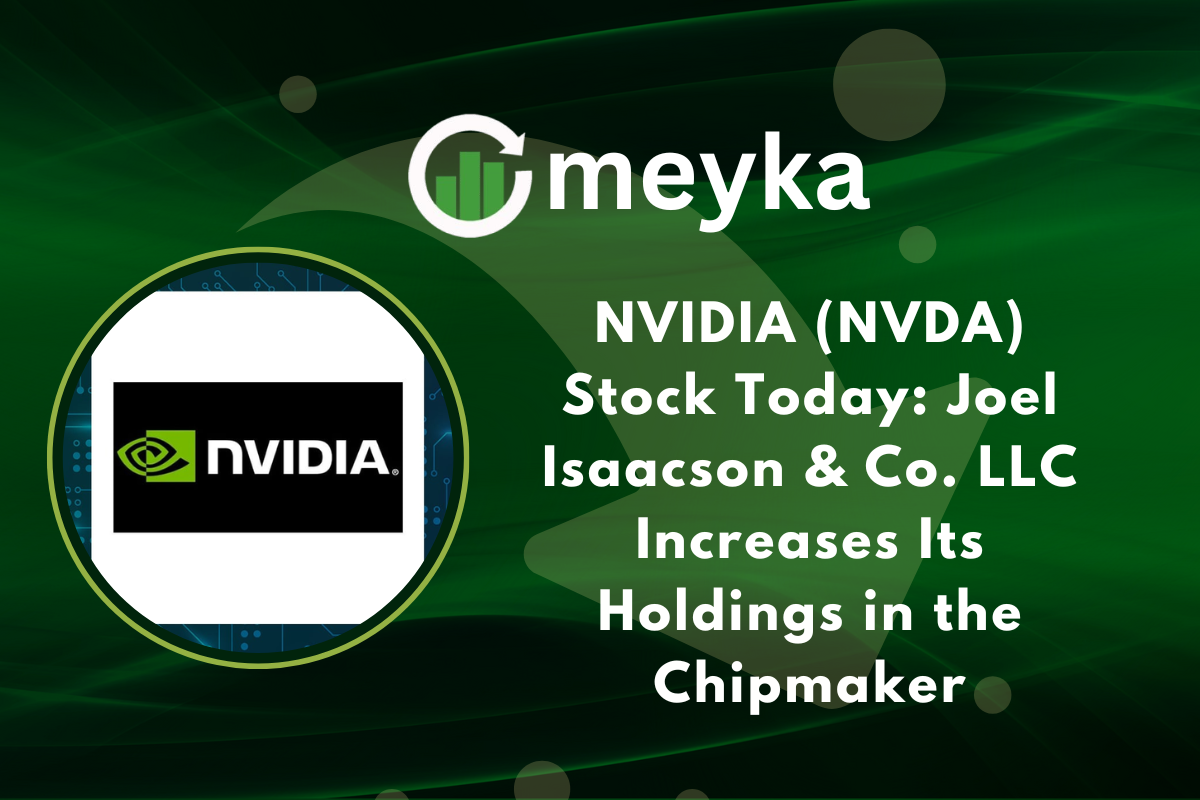NVIDIA (NVDA) Stock Today: Joel Isaacson & Co. LLC Increases Its Holdings in the Chipmaker
Joel Isaacson & Co. LLC increased its stake in Nvidia by 17.4 percent, adding 10,576 shares in the most recent quarter. The move boosts investor confidence in the chipmaker, as other institutions also adjust positions amid strong demand for AI chips and data center GPUs.
What does this mean for Nvidia shareholders and the broader semiconductor sector? Read on for the facts, context, and what to watch next.
Nvidia institutional buying and what it signals
Joel Isaacson & Co. LLC now owns 71,366 shares of Nvidia (NVDA), worth roughly $11.3 million at quarter’s end. This change was disclosed in an SEC filing and reported by MarketBeat. The increase shows continued faith by boutique and mid-sized managers in Nvidia’s AI-led growth story.
Why did Joel Isaacson & Co. increase its stake in Nvidia? The firm likely sees strong revenue momentum and expanding margins driven by GPUs used in AI and data centers, making Nvidia a core holding.
Other institutional moves: Triagen and broader ownership
MarketBeat also flagged moves by TriaGen Wealth Management, which reduced its stake but still holds nearly 50,000 shares valued at about $7.89 million. Overall, institutional investors own around 65 percent of Nvidia stock, a sign of heavy professional participation. These shifts reflect active portfolio rebalancing rather than a uniform buy or sell signal.
What does institutional buying mean for average investors? It signals professional interest, but investors should still weigh valuations and company fundamentals before following.
Nvidia stock performance and market context
Nvidia trades on the Nasdaq, and its shares continue to lead the semiconductor sector. The company has delivered strong growth, with recent quarters showing significant year-over-year revenue gains driven by AI computing needs.
Nvidia (NVDA) remains a major component of the Nasdaq 100 and a bellwether for AI market momentum.
Recent financial highlights
- Nvidia (NVDA) reported strong revenue gains in recent quarters, with double-digit growth driven by data center sales and AI-related products.
- Profit margins expanded due to high demand for GPUs and value-added software solutions.
- Analysts continue to model high growth for data center chips and AI platforms as the primary revenue driver.
Is Nvidia’s growth sustainable? Many analysts say yes, because AI workloads and cloud adoption require more GPU power, but valuation multiples already price in much of that growth.
Why Nvidia matters to the AI market
Nvidia (NVDA) is widely viewed as the leading AI Stock, given its dominant position in GPUs for training and inference. The company’s products are central to modern AI stacks used by cloud providers, enterprise AI teams, and research labs.
Role in AI infrastructure and competition
- GPUs: Nvidia’s GPUs remain the industry standard for large-scale AI training.
- Data centers: Strong demand from hyperscalers supports revenue and unit growth.
- Competition: AMD and Intel are active competitors, but Nvidia retains a performance edge in many AI workloads.
How does Nvidia compare with rivals? Nvidia leads on software ecosystem and performance, though rivals are narrowing the gap in some segments.
Analyst sentiment and valuation
Most analysts maintain a favorable view of Nvidia, citing revenue growth from AI, strong margins, and expanding software monetization. Price targets vary, and consensus reflects optimism tempered by high valuation.
What analysts are watching
- Earnings guidance and data center revenue trends.
- Gross margins as supply and pricing dynamics evolve.
- AI product adoption outside hyperscalers, particularly in enterprise customers.
Will analysts change their ratings after institutional trades? Institutional buying can influence sentiment, but analysts focus on fundamentals and outlook in their models.
Institutional moves: what the SEC filings reveal
The SEC filings provide granular data on who buys and who trims positions. Joel Isaacson’s increase is notable because it is a meaningful percentage rise for that firm, and it adds to a pattern of selective accumulation by several managers reported in the quarter. TriaGen’s reduction illustrates that not all institutions are adding at the same time, highlighting portfolio-specific strategies.
Filing highlights
- Joel Isaacson & Co. LLC increased holdings by 17.4 percent to 71,366 shares.
- TriaGen Wealth Management trimmed its position to 49,953 shares, a 32.7 percent reduction.
- Institutional ownership stands near 65 percent of total shares outstanding.
What should investors take from filings? Filings show who is positioning for long-term growth and who is rebalancing; use them as context, not a trading signal.
AI research and market tools shaping investor views
Investors increasingly use algorithmic tools to analyze large data sets and company signals. AI Stock research platforms scan filings, earnings calls, and supply chain data to surface trends relevant to Nvidia and peers.
How AI informs decision-making
- Data-driven research helps identify demand shifts for GPUs.
- Sentiment analysis on earnings calls can show management tone and forward-looking cues.
- These tools complement traditional analysis but do not replace deep fundamental review.
Should retail investors rely on AI tools alone? No, combine AI insights with financial metrics and risk management.
Nvidia as a benchmark in AI Stock Analysis
Nvidia’s performance is often used as a benchmark in AI Stock Analysis because its revenues reflect broader enterprise and cloud investment in AI compute.
What benchmark status implies
- Nvidia (NVDA) moves often correlate with sentiment in AI-related equities.
- Strong Nvidia (NVDA) quarters can lift chipmakers and software firms tied to AI.
- Weakness in Nvidia may signal cooling demand, prompting sector revaluation.
What does this mean practically? Portfolio managers may rebalance sector exposure based on Nvidia trends.
Risks and what to watch
Nvidia (NVDA) is a growth leader but faces risks including valuation pressures, increased competition, cyclical demand, and geopolitical supply chain issues.
Key risk signals
- Any slowdown in data center spending.
- Increased GPU competition from AMD and Intel.
- Regulatory or export restrictions impacting chip sales.
How to manage risk? Diversify, size positions appropriately, and monitor quarterly guidance.
Quick facts: Nvidia at a glance
- Ticker: NVDA, listed on Nasdaq.
- Core business: GPUs and AI computing platforms.
- Institutional ownership: Roughly 65 percent.
- Recent notable moves: Joel Isaacson & Co. LLC increased holdings by 17.4 percent.
Social signal
Market news outlets and analysts shared the filing reports on social channels as the trades were reported. See MarketBeat’s filing alert for details and context.
Conclusion: What the Joel Isaacson move means for Nvidia
Joel Isaacson & Co. LLC’s stake increase is a vote of confidence in Nvidia and its AI-led growth path. Institutional activity is mixed, but the overall trend shows continued professional conviction in the chipmaker’s role in AI infrastructure. For investors, Nvidia remains a high conviction yet high valuation name, best approached with clear risk limits and a long-term horizon.
As AI demand grows, Nvidia’s positioning as a leading AI Stock will keep it central to technology portfolios, but close attention to earnings and data center trends is essential.
FAQ’S
The biggest shareholder of Nvidia is The Vanguard Group, followed by BlackRock Inc., both holding significant institutional stakes in the chipmaker.
Yes, Nvidia’s market value briefly dropped by about $279 billion in a single trading day due to a broad tech sell-off and investor profit-taking after strong earnings.
No, BlackRock does not own 75% of Nvidia. It holds roughly 6%–7% of the company’s shares, making it one of the top institutional investors but not a majority owner.
If you invested $10,000 in Nvidia a decade ago, it would be worth over $1 million today, thanks to the company’s massive stock growth fueled by AI and GPU demand.
A $10,000 investment in 2015 would now be worth around $450,000–$500,000, showing Nvidia’s incredible rise during the AI and data center boom.
While not officially confirmed, reports suggest a large portion of Nvidia employees became millionaires through stock-based compensation as the company’s share price skyrocketed.
Disclaimer
The content shared by Meyka AI PTY LTD is solely for research and informational purposes. Meyka is not a financial advisory service, and the information provided should not be considered investment or trading advice.”






